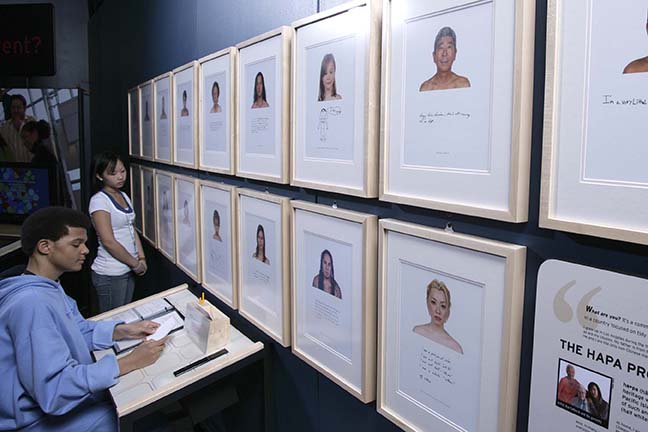
The Chicago History Museum welcomes the exhibition, Race: Are We So Different, opening Saturday, November 11. “This exhibition is critically important here, at the Chicago History Museum, and now as contemporary events continue to remind us that our claims of a post-racial society are not yet realized,” said Joy Bivins, director of curatorial affairs at the Chicago History Museum.

Having seen a portion of this exhibition a couple of years ago, I am thrilled that the Chicago History Museum is offering Chicago a second chance. “This will be the first time that all 5,000 square feet of the exhibition has been to Chicago. It will also be the longest run in Chicago, at seven months.” according to Emily Osborne. This remains a very important, must see exhibition.
People are different. Throughout history, these differences have been a source of community, strength and personal identity. They have also been the basis for discrimination and oppression.
The Chicago History Museum offers an unprecedented look at the history, science and social experiences of race and racism in the United States with the exhibition, RACE: Are We So Different? opening Saturday, November 11, 2017.

“Race, arguably, remains the most contentious and divisive issue in American society. This exhibition is critically important here, at the Chicago History Museum, and now as contemporary events continue to remind us that our claims of a post-racial society are not yet realized,” said Joy Bivins, director of curatorial affairs at the Chicago History Museum. “RACE will offer Museum visitors a chance to explore the science and history of a concept that has had and continues to have a real and devastating impact in people’s lives, throughout the nation and in our own city.”
RACE, developed by the American Anthropological Association in collaboration with the Science Museum of Minnesota, is the first national exhibition to tell the stories of race from the biological, cultural and historical points of view. The three sections are interwoven and tell a compelling story of science with deep and lasting social impact.

- History: Explore the history of race in the United States as a set of beliefs and social practices that were taken up in the name of law and science to develop a system that justified slavery and the unequal treatment of people. Through a set of historical vignettes, RACEwill examine how this belief system in its various forms has shaped the history of this country and society.
- Science: Visitors can analyze our common human ancestry, learn about the continuum of human variation, question common notions of race as discrete biological groups and investigate the past and current science behind human variation.
- Race in Contemporary Life: The exhibition will delve into the concept of race, which affects nearly every social institution in our lives. RACE examines the social and personal experiences of race in familiar contexts such as our communities, schools, doctor’s offices, the legal system and the marketplace.
The exhibition’s powerful combination of artifacts, historic and contemporary photography, multimedia components and interactive elements will give visitors of all ages the opportunity to think and talk about a topic that touches our lives daily. Highlights include:
- Who’s Talking? an activity that invites visitors to match voices they hear with people in photos based on speech patterns and inflection, with surprising results.
- The Colors We Are, an activity that allows visitors to scan their skin and watch their shade appear as a color “chip” on a computer screen mosaic next to chips from dozens of other visitors.
- An exploration of the United States Census that demonstrates how our conception of race is ever-changing and has morphed throughout American history according to social, economic and political forces.
- A study of high blood pressure and the people that suffer from it that reveals the complexity of race, racism and medicine.
The Museum will offer public programs to highlight the local ties to the RACE exhibition. A civic talk series will bring together speakers and community experts to discuss the impact of race and racial segregation in Chicago. The series will begin in winter 2018.

Educational programs tailored for middle and high school students will give youth the opportunity to talk about the history of race in Chicago, with guidance from facilitators, and how it continues to impact contemporary life.
Admission to RACE is included with regular Museum admission ($16 adults/ $14 seniors and students, and free for children 12 years of age and younger). The exhibition will run through Sunday, July 15, 2018. For more information on RACE at the Chicago History Museum visit chicagohistory.org/race.
Race: Are We So Different? is supported by education sponsor Allstate and media sponsors NBC 5 Chicago and Univision. Established in part by The Elizabeth Morse Charitable Trust and Elizabeth Morse Genius Charitable Trust, the Exhibition Innovation Fund has provided additional funding for Race: Are We So Different?
ABOUT THE CHICAGO HISTORY MUSEUM
The Chicago History Museum, a major museum and research center for Chicago and American history, is located at 1601 N. Clark Street. The Museum can be reached by CTA buses 22, 36, 72, 73, 151, and 156. Parking is conveniently located one block north of the Museum at Clark and LaSalle Streets (enter on Stockton Drive). Admission includes our audio tours: $16 adults, $14 seniors/students, free for children 12 years and younger. Please call 312-642-4600 or visit us at chicagohistory website. To learn more follow us on Facebook and Twitter. The Chicago History Museum gratefully acknowledges the support of the Chicago Park District on behalf of the people of Chicago. The Chicago History Museum is a 2016 winner of the National Medal for Museum and Library Service, the highest award given to these institutions for their community engagement and having an impact on the lives of individuals, families, and communities.

Be the first to comment